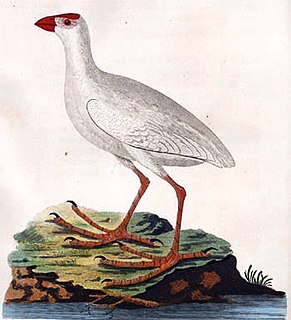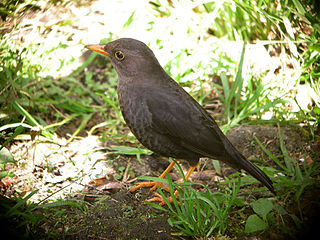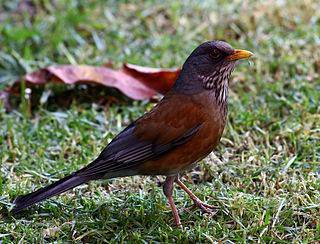
The common blackbird is a species of true thrush. It is also called the Eurasian blackbird, or simply the blackbird where this does not lead to confusion with a similar-looking local species. It breeds in Europe, Asiatic Russia, and North Africa, and has been introduced to Australia and New Zealand. It has a number of subspecies across its large range; a few of the Asian subspecies are sometimes considered to be full species. Depending on latitude, the common blackbird may be resident, partially migratory, or fully migratory.

Lord Howe Island is an irregularly crescent-shaped volcanic remnant in the Tasman Sea between Australia and New Zealand, 600 km (320 nmi) directly east of mainland Port Macquarie, 780 km (420 nmi) northeast of Sydney, and about 900 km (490 nmi) southwest of Norfolk Island. It is about 10 km (6.2 mi) long and between 0.3 and 2.0 km wide with an area of 14.55 km2, though just 3.98 km2 of that comprise the low-lying developed part of the island.

The white swamphen, also known as the Lord Howe swamphen, Lord Howe gallinule or white gallinule, is an extinct species of rail which lived on Lord Howe Island, east of Australia. It was first encountered when the crews of British ships visited the island between 1788 and 1790, and all contemporary accounts and illustrations were produced during this time. Today, two specimens exist: the holotype in the Natural History Museum of Vienna, and another in Liverpool's World Museum. Although historical confusion has existed about the provenance of the specimens and the classification and anatomy of the bird, it is now thought to have been a distinct species endemic to Lord Howe Island and most similar to the Australasian swamphen.

The Lord Howe woodhen also known as the Lord Howe Island woodhen or Lord Howe (Island) rail, is a flightless bird of the rail family, (Rallidae). It is endemic to Lord Howe Island off the Australian coast. It is currently classified as endangered by the IUCN.

The South Island piopio also known as the New Zealand thrush, was a passerine bird of the family Oriolidae.

The island thrush is a common forest bird in the thrush family. Almost 50 subspecies have been described, ranging from South East Asia and Melanesia, to Samoa, exhibiting great differences in plumage. Several subspecies are threatened and three have already become extinct.
The Grand Cayman thrush is an extinct bird from the thrush family (Turdidae). It was endemic to the island of Grand Cayman in the Caribbean.
The Tasman starling was described in 1836 by John Gould as a species which occurred on both Norfolk Island and Lord Howe Island. In 1928 Australian ornithologist Gregory Mathews recognized that the plumage of the race from Lord Howe Island was much browner and more greyish than the plumage of the Norfolk Island race and split the species into two forms, the Norfolk starling, and the Lord Howe starling. Both subspecies are now extinct, thus so the species.

The Sulawesi thrush is a species of passerine bird, monotypic within the genus Cataponera in the thrush family, Turdidae. It is endemic to the island of Sulawesi in Indonesia, where it inhabits evergreen montane forests at altitudes of 1,100–2,400 m (3,600–7,900 ft). Although it has a limited range and is not a common bird, the IUCN has assessed it as being a "least-concern species".

The Lord Howe gerygone or Lord Howe gerygone flyeater was a small bird in the family Acanthizidae, brown and greyish in color. Its head was brown apart from a pale grey eye-ring and a grey throat and chin, many parts of the animal varied to the colour of yellow, this being apparent in its bright yellow belly. It made its home in the canopies of the island's forest until the early 20th century. The bird has had a variety of monikers: locally, it was known as the "rain-bird" due to its activity after the rains, or the "pop-goes-the-weasel", due to the similarity of its song to the well-known tune. The bird was endemic to Lord Howe Island in the Tasman Sea. There have been no records of the species since 1928, and it is considered to be extinct. Its extinction is almost certainly due to predation by black rats which were accidentally introduced to the island in 1918 following the shipwreck of the SS Makambo there.

The Comoros thrush is a species of bird in the family Turdidae. It is found in the Comoros Islands in the south western Indian Ocean.

The Acanthizidae—known as the bristlebirds, pardalotes and Australian warblers—are a family of passerine birds which also include gerygones, the thornbills Acanthiza, and the scrubwrens of Sericornis. The Acanthizidae family consists of small to medium passerine birds, with a total length varying between 8 and 19 centimetres. They have short rounded wings, slender bills, long legs, and a short tail. Most species have olive, grey, or brown plumage, although some have patches of a brighter yellow. The weebill is the smallest species of acanthizid, and the smallest Australian passerine; the largest is the pilotbird.

The rufous-backed thrush is a songbird of the thrush family. It is endemic to the Pacific slope of Mexico. It is also known as the rufous-backed robin.

The Norfolk thrush, also known as the grey-headed blackbird or guava bird, was a bird in the thrush family endemic to Norfolk Island, an Australian territory in the Tasman Sea. It is the extinct nominate subspecies of the island thrush.

The Christmas thrush, ia a subspecies of the island thrush. It is endemic to Christmas Island, an Australian territory in the Indian Ocean.

The Taiwan thrush is a bird in the thrush family. It is endemic to the island of Taiwan.

SS Makambo was a steamship first owned by Burns Philp & Co. Ltd. She was built in Port Glasgow in Scotland and named after an island in the Solomon Islands. She carried both passengers and cargo and was principally used on routes between eastern Australia and islands in Melanesia and the Tasman Sea. In November 1908 Jack and Charmian London travelled from Guadalcanal to Sydney on the Makambo after abandoning their ill-fated circumnavigation of the world on the Snark, a 45' sailing yawl.

The Lord Howe boobook, also known as the Lord Howe morepork, was a bird in the true owl family endemic to Lord Howe Island in the Tasman Sea, part of New South Wales, Australia. It is an extinct and little-known subspecies of the morepork.


















